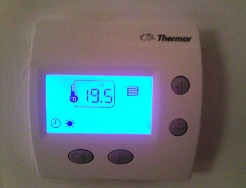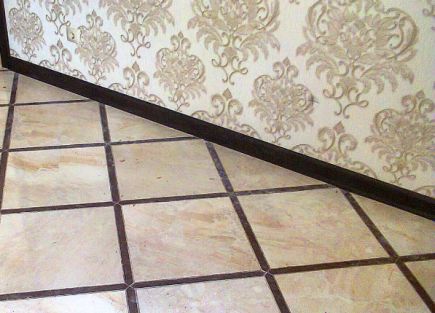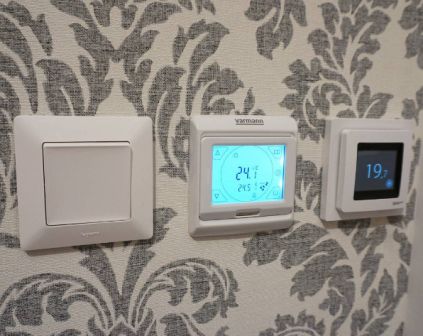Categories: Featured Articles » Electrician Secrets
Number of views: 583828
Comments on the article: 56
What to do if the warm floor does not work
The device of a heat-insulated floor, troubleshooting
 Warm floors are becoming extremely popular, despite their relatively high cost. The heat coming from the floor surface not only warms the air in the room, but also gives a feeling of comfort, allows you to walk around the house without shoes and, without any exaggeration, creates an atmosphere of home comfort. This is especially true for rooms with a cold tiled floor - bathrooms, kitchens, corridors. But even laminate or linoleum more often hide a film infrared warm floor underneath.
Warm floors are becoming extremely popular, despite their relatively high cost. The heat coming from the floor surface not only warms the air in the room, but also gives a feeling of comfort, allows you to walk around the house without shoes and, without any exaggeration, creates an atmosphere of home comfort. This is especially true for rooms with a cold tiled floor - bathrooms, kitchens, corridors. But even laminate or linoleum more often hide a film infrared warm floor underneath.
Installation of underfloor heating is not technically particularly difficult, but malfunctions of such a floor can bring a real headache. The floor is mounted, it is possible that it is even poured with a concrete screed, and suddenly it turns out that floor heating does not work. What to do? Let's try to understand this situation.
Underfloor heating
First you need to decide on electric underfloor heating device. It, in the general case, consists of the following elements: a thermostat (regulator), a sensor, and a heating cable itself. A cable can be self-regulating (changing its resistance depending on temperature) or resistive, whose resistance is conditionally independent of temperature. In any case, an electric current is passed through the cable, which heats the conductor, its insulating sheath, a concrete screed, and so on. If the cable length is verified with sufficient accuracy, the cable and the insulation are not at risk of temperature damage.
It is precisely because of the requirements of thermal resistance that heating cables cannot be cut in any order: if the heating wire is too short, its resistance will be low, the current will increase and cause damage. The most common two types of cable:
1) a single two-wire wire, often connected by a mesh base and blanked on one side. Such a cable is usually mounted in a concrete screed. You can’t cut it categorically, so it is selected strictly according to the area of the room, free from furniture or plumbing.
2) two main single-core wires located parallel to each other and connected by heating wires. This is also a cable mounted in a cable tie. It differs in that it can be cut during installation strictly across, without fear for the integrity of the insulation.

The infrared film floor works a little differently, but from the point of view of any electrician, it is also just a circuit of active resistances. Convenient film floor in that, due to its small thickness, it can be installed under any floor covering. You can cut the floor film, but only across and along special marking lines.
Thermostat for underfloor heating, or, as it is often called, a regulator, is an electronic device that controls the supply of voltage to a heated wire of a warm floor. To the terminals L and N of the thermostat are connected, respectively, the "phase" and "zero" of the household network 220 volts, and the wires of the warmest floor are connected to the terminals that have digital designations and are exactly indicated in the controller's passport.
During operation, the thermostat constantly compares the temperature of the medium around the heating cable or floor film with the temperature set by the user. If the temperature is lower than the task, voltage is applied to the warm floor, an electric current occurs and heating occurs. When the temperature reaches the required level, the thermostat turns off the power and the current stops flowing.
The thermostat makes conclusions about the current temperature in the space around the warm floor thanks to the temperature sensor, which is most often poured into the floor screed together with the floor in a special shell. A temperature sensor is a resistor whose resistance is directly proportional to temperature.The findings of this resistor are also connected to the special terminals of the controller.
The directly heated floor in the form of a cable or film, as well as a regulator with a temperature sensor, can always be purchased separately of your own choice - the vast majority of brands and models combine perfectly. Expensive controllers, among other things, are equipped with various additional functions: such as a clock with an alarm clock or a built-in radio. But the essence remains the same - it's just a regulator of the floor temperature.

Faults and possible solutions
The first malfunction that may come to mind is the lack of input voltage. The circuit breaker has tripped (for a warm floor, preferably a differential one) or the line is damaged. This is not at all difficult to verify: for most regulators, the presence of voltage at the input is indicated by symbols on the LCD screen or by the glow of a special LED. If you do not trust these signs, then you can carefully remove the regulator from the socket and measure the voltage at terminals L and N multimeter.
If the food is in order, then we have three “suspects”: a warm floor, a regulator and a sensor. Underfloor heating can be checked by measuring its resistance to direct current. Since the load that such a floor represents is purely active, this resistance will be equal to the real resistance of the heating cable.
So, measure the resistance of the cable or heating film and draw conclusions. We divide the network voltage (220 volts) by the resistance obtained in Ohms - we get the current theoretically flowing through the warm floor. We multiply this current by 220 volts again and we get the power consumed by the floors from the network. Then we can compare this power with the passport value of the warm floor. If it turns out that the floors consume significantly more power, then this indicates the presence of short circuits and, most likely, insulation damage. At the same time, some part of the floor may not work, while the other, on the contrary, will heat with more force, but probably not for long, since increased current will quickly render the cable unusable.
Too small power consumption indicates that the cable circuit has breaks that allow electric current to pass through, but increase the resistance of the circuit. This leads to a decrease in the efficiency of the warm floor and its unstable operation.
If the passport power of the floor is unknown to you, then it can be determined approximately, based on the calculation of 150 watts per square meter.
The almost complete absence of resistance of the cable underfloor heating indicates that there is a short circuit in the circuit. If we are talking about a cable poured into the floor, then the issue of troubleshooting is removed, because the replacement or repair of a cable located in the floor is extremely rare. If this is a film floor, then you can lift the coating and try to find the place where the short circuit occurred.

If the floor itself, thank God, was correct, then go to the temperature sensor. Since the sensor is essentially a resistor, it must have some kind of active resistance. It is usually calculated in kilograms, and is measured with a multimeter at the appropriate limits. It should be borne in mind that the resistance of the sensor directly depends on its temperature (for that it is the sensor). For example, for a sensor with a nominal resistance of 10 kΩ, the multimeter may vary from 22 kΩ at 5 degrees to about 6 kΩ at 40 degrees. It is not so difficult to determine the proportion and critically evaluate the state of your temperature sensor. Some digital controllers when a sensor malfunctions display a message on their display.
It is possible to replace the sensor even for poured floors, as it is installed in a special protective tube facing out. Maximum will have to slightly damage the wall to get to it. Sensors for underfloor heating are on sale at a very low price.
If the sensor turned out to be in order, then most likely the regulator itself failed. You can check it using the same multimeter. We connect power to the thermostat, connect the sensor, and fold the ends leading to the warm floor. We set the maximum temperature. The internal relay should turn on, and voltage should appear on the terminals used to connect the floor. We turn the knob in the opposite direction and set the minimum temperature. The relay should work, and the multimeter should show the absence of voltage at the working terminals.
A malfunction of the underfloor heating regulator is a malfunction that allows you to do with a little blood. Indeed, it is much simpler and easier to replace the regulator than to open the floor covering and look for ways to replace the warmest floor. Replacing the sensor is also not always a pleasant procedure, therefore, if your underfloor heating ceased to work, it is better to hope that it is only in the regulator.
See also at bgv.electricianexp.com
:
